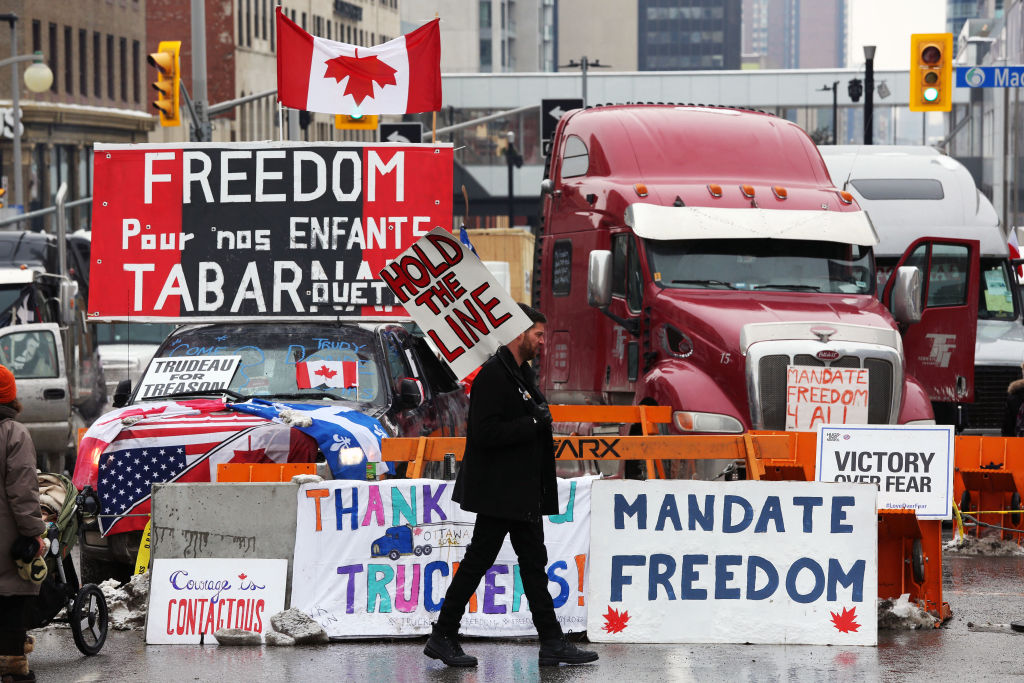Four Canadian provinces have agreed to modify or abolish their COVID-19 restrictions in the face of ongoing protests led largely by the nation’s truckers.
That’s not bad for a movement that Canadian Prime Minister Justin Trudeau dismissed as a “small fringe minority” when it started late last month.
Canada’s vaccine mandate for all truckers entering the country went into effect Jan. 15 and became the catalyst for the truckers to form the Freedom Convoy, even though the vast majority of truck drivers in Canada had already gotten the jab.
And, while other nations continue rolling back their restrictions, Trudeau has remained wedded to his plan in the face of these ongoing protests.
“The reality is that vaccine mandates, and the fact that Canadians stepped up to get vaccinated to almost 90 percent, ensured that this pandemic didn’t hit as hard here in Canada as elsewhere in the world,” Trudeau stated in Parliament in the capital city of Ottawa on Wednesday, according to The Associated Press.
However, it appears their efforts are making inroads for the cause as the provinces of Quebec, Alberta, Saskatchewan, and Prince Edward Island have announced they will lift some or all of the restrictions, the AP reported.
Alberta, considered to be the more politically conservative of Canada’s 10 provinces, will immediately abolish its vaccine passport requirement and nix the masks mandate before March 1.
This comes as the massive “freedom truck convoy” continues to clog the streets of the capital city of Ottawa and a key U.S.-Canada border crossing.
Protesters have vowed to continue their demonstrations to regain the freedoms lost to the pandemic and their resolve could spell disaster for international commerce.
“Candian Freedom Convoy causes Ambassador Bridge to be closed at the Detroit and Windsor border again today,” WEYI-TV news anchor Dave Bondy tweeted Tuesday with a photo of the bridge that carries a quarter of all trade between the nations blockaded by truckers on the inbound side.
Candian Freedom Convoy causes Ambassador Bridge to be closed at the Detroit and Windsor border again today. Story: https://t.co/J9eOJEPnfG pic.twitter.com/kgZczI6d0b
— Dave Bondy (@DaveBondyTV) February 8, 2022
Windsor Mayor Drew Dilkens has been reluctant to clear the bridge that has been crowded with nearly 70 vehicles for three days, though he promised the city wouldn’t “let this happen for a prolonged period of time,” the AP reported.
The fact that Canadians have staged such a bold and prolonged demonstration at all is surprising considering that the nation’s citizens are generally compliant when it comes to their government — but Trudeau’s vaccine mandate for truckers was enough to change that.
Even for those who are willing to submit to the medical procedure realize that forcing others to do it is unethical and an assault on personal freedom and bodily autonomy.
Perhaps that’s why the movement against the mandate raised millions of dollars to keep vehicles parked in the nation’s capital to send a message to Trudeau, though he conveniently went into hiding as the convoy rolled into town late last month.
Before the four provinces walked back their mandates and measures, the Canadian government tried to quash the protests using several tactics.
The truckers were barred from honking their horns in the convoy and supporters were prohibited from bringing food and fuel to the participating vehicles.
The crowdfunding platform GoFundMe shut down Freedom Convoy’s fundraising page, with many donors at first fearing that their money would be disbursed to competing causes. The Christian fundraising site GiveSendGo took over.
But despite that immense pushback on those fronts, the convoy has endured and appears to be working.
The takeaway from this situation is that peaceful protests work if they’re strategically planned and lawfully executed.
Moreover, this is proof positive that the people often invisible to elite politicians perform some of the most essential jobs — and their discontent can easily bring a nation to its knees if they’re pushed too far.
This article appeared originally on The Western Journal.

























 Continue with Google
Continue with Google